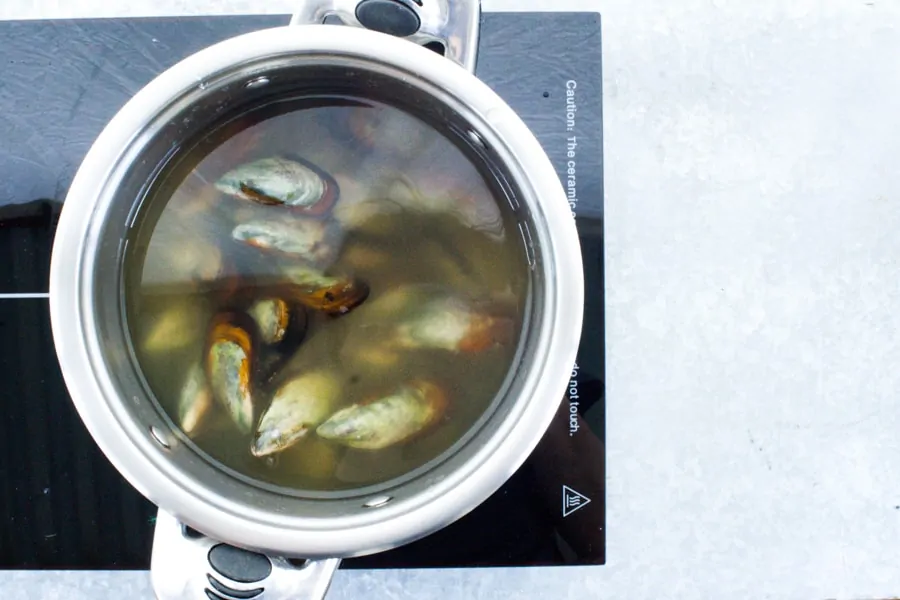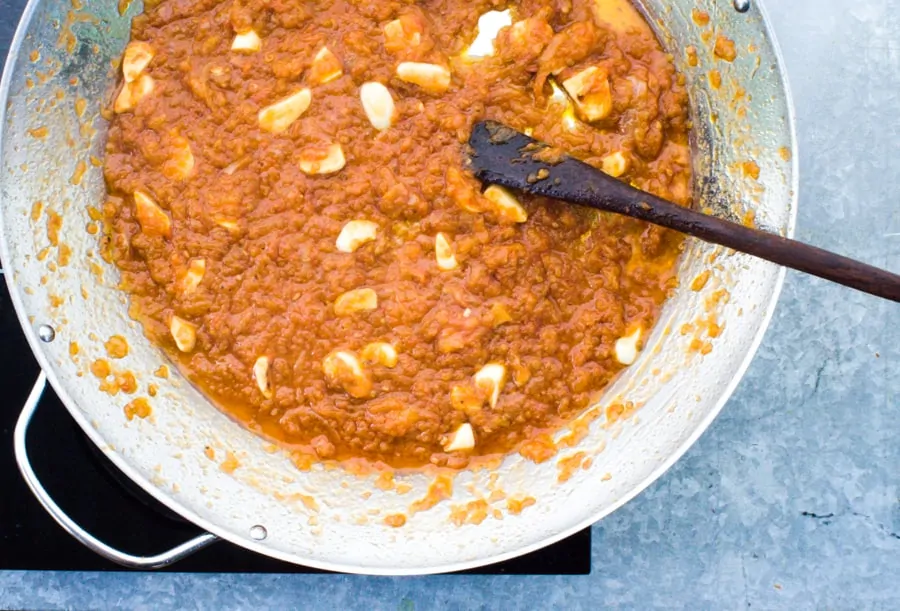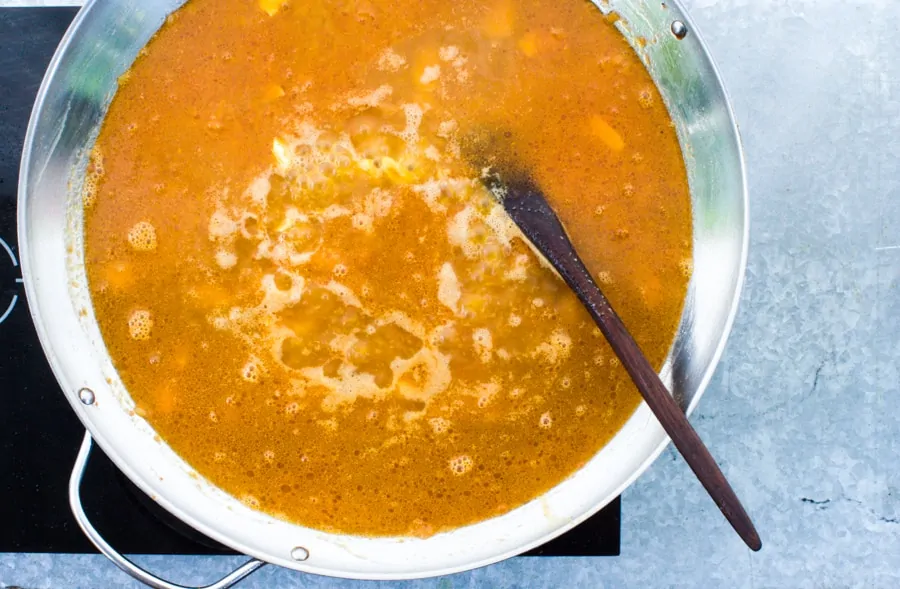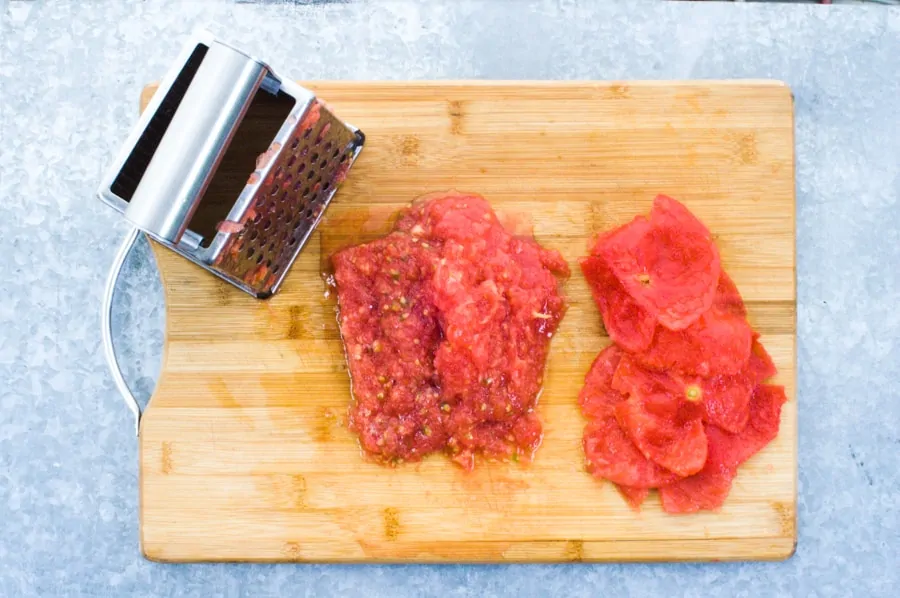
Nothing breathes Spanish cuisine as much as a paella. So much so, that paella is considered to be Spain’s national dish. Actually, it is technically a regional dish from Valencia. But its aromatic flavors have made it one of Spain’s most popular dishes the world over.
If you are unfamiliar with paella, let’s quickly take a look at the structure of the dish. Paella is a rice dish, where the rice is simmered in a combination of sauce and broth along with typically chicken or seafood, in a large flat pan. This method imbues the rice with bucket loads of flavor, making it the star of the dish.
The original or traditional paella from Valencia is made with either chicken, rabbit or duck and vegetables and beans. The spread of the dish to the coastal regions of Spain birthed the seafood paella variations, and modern takes on paella have introduced further new ingredients such as chorizo sausage and pork.
Paella is essentially a very simple dish to make, while being rewarding in its depths of flavor. There are however a few tricks and tips to making a great paella.
The first one of these, concerns the sauce in which the rice is cooked. Many paellas are started by making a tomato, onion and garlic sauce by simmering the ingredients together in the paella pan. This is called a sofrito. The sofrito should ideally cook for up to 40 minutes or even longer in order to sweeten and deepen in flavor. The trick with the sofrito is not to burn it. One does not want browning to occur. So if you see the tomato and onion mix sticking or browning, add a little water to deglaze the pan and you will be able to continue cooking the sofrito without getting bitter or burnt notes.
The other tips concerns the rice. Firstly, be sure to use round grain rice as it is most suited to paella recipes. Second, once the rice has absorbed all of the liquid in the pan, and is close to being fully cooked, it should start to crispen on the bottom and form a chewy layer. The Spanish term for this is socarrat. Now because most paella pans are larger than most hot plates, burners and hobs, you will need to rotate your pan around on the heat, to ensure an even crispening of the rice on the bottom of the pan. This is very important, otherwise one can end up with a burnt ring in the center, and not much socarrat.
Not let’s talk briefly about the flavoring behind this paella recipe. Seafood paellas often contain a variety of seafood, but being a mussel lover I wanted to develop a mussel on mussel paella recipe. And for most mussel lovers the only thing better than mussels… is smoked mussels. Having to make smoked mussels at home of course is a lot to ask if one does not have a smoker. So I hacked it and incorporated a can of smoked mussels along with the fresh ones. The result is a small explosion of mussel based umami!
To increase the amount of mussel flavor in the rice, the mussels are cooked in broth, and the broth is then used for the rice. The already cooked mussels can then simply be placed on top of the paella before serving. Generally the seafood is cooked on top of the rice. With this method one is able to gain maximum mussel flavor in the rice, and you also do not need to worry about the timing of when to incorporate the mussels into the paella for optimum cooking. Which allows you to place your full attention on the rice and its socarrat.
Not all of us have a paella pan in the cupboard, so feel free to use a large skillet pan. The important part is that it is large enough so that the rice will form a thin layer when fully cooked. Thicker paellas can be soggy and heavy. A thinner layer of rice will allow more socarrat to develop and for the rice to cook evenly.

Smokey Mussel Paella
Ingredients
- Olive oil for frying
- 1 large onion
- 2-3 to matoes
- Salt
- 6 cloves of garlic
- ½ cup white wine
- 3 ½ cups of vegetable stock
- 800 grams +-30 fresh mussels, scrubbed and debearded
- 1 pinch of saffron +-30 threads
- 1 can of smoked mussels
- 1 ¼ cups round grain rice
- 1 teaspoon ground chilli
- 2-3 lemons for garnish
- ⅓ cup chopped parsley
Instructions
-
Start off by assembling all of your ingredients. Make sure that the mussels are clean and debearded. Also, open the can of smoked mussels and remove the mussels from the oil which covers them, and set aside reserving the oil as well.
-
The first step of the paella to get on the go is the ‘sofrito’ component, which is a simple tomato, onion and garlic sauce, made by cooking the tomato, onion and garlic together for up to 40 minutes. To begin, take you tomatoes and cut them in half. Then using a box grater, grate them starting on the inside. The tomato will grate into the box, and you will be left holding the empty tomato skin.
-
Next grate the onion, and peel and thickly slice the garlic.
-
Place your paella pan onto the stove, add a generous amount of olive oil to coat the bottom of the pan, scrape the onion in, and sprinkle in a pinch of salt. Cook for a few minutes.
-
After a few minutes of cooking the onion, add in the grated tomato, and another pinch of salt. Reduce the heat to medium low and cook for approximately 20-40 minutes, adding the garlic in halfway through and stirring intermittently. You do not want to brown the sofrito. Rather to reduce and sweeten it. So if you see the sofrito beginning to stick to the bottom of the pan or burning at all, add in small amount of water and scrape off the browning. This will deglaze the pan and stop further browning from occurring.
-
Halfway through cooking the sofrito, add in the garlic.
-
While the sofrito is simmering, you can cook the mussels. The idea is to lightly simmer them in white wine and stock, until they have all opened. Once this happens set them aside and reserve the liquid. So to do this, place the live mussels and the smoked mussels from the can into a large pot. Pour in the ½ cup of white wine and 3 ½ cups stock, and place the lid onto the pot. Bring to a gentle simmer, and cook until all or most of the mussels have opened. This takes roughly 5 minutes. After turning off the heat, discard any mussels which have not opened. Remove the opened mussels from the pot and set them aside, strain the liquid and discard the canned smoked mussels pieces, reserving the liquid.
-
While the mussels are cooking there is another step you can perform. And that is to toast the saffron. There are a number of ways you can do this, but one of the safest ways is to take the saffron filaments and fold them into a small piece of aluminium foil. Then place your little “packet” into a hot skillet or saucepan. Remove after approximately 1 minute, and check the inside. The saffron should be slightly brittle to the touch. This means it is ready to be crushed.
-
Place the toasted saffron into a mortar and pestle and grind it up into a powder. If you do not have a mortar and pestle you can use the back of a spoon and a saucer.
-
Combine the saffron with the broth by stirring it into the pot in which you cooked the mussels At the same time, salt the broth. You should use approximately 2 teaspoons of salt, and taste it. It should taste well salted. The saffron and salted broth should then infuse together until the sofrito is done.
-
Once the sofrito has finished cooking in the paella pan it is time to bring in the rice. Add the dry rice to the sofrito as well as the oil from the tin of smoked mussels, and with a spoon or spatula mix to combine.
-
Now add in 3 ¾ cups of your broth into the paella pan (reserving ¼ cup in case the pan needs a little extra later on) and the chilli flakes. Turn the heat up to high and evenly disperse the rice over the bottom of the pan. Allow the pan to simmer briskly for approximately 10 minutes. After which, turn down the heat to a medium low and cook gently for another 8-10 minutes. If you find that the rice on top is not cooking as fast as the rice at the bottom of the pan, you can place a lid over the pan towards the end to help the rice cook evenly.
-
At this point, the rice should start to crispen on the bottom of the pan. To encourage even crispening, try to move the pan around on the flame, to ensure that all areas get enough of the heat to form a crispened layer. This is what is termed socarrat in Spanish, and it is the most sought after part of a good paella. You can also check to make certain that socarrat is forming by inserting a spoon into the rice layer and feeling to see if there is any stiffness to the bottom layer of rice. If there is, this means that socarrat is forming and you are almost ready to serve. Do not overdo this part either, as you just want the bottom layer of rice crispened, not burnt.
-
Now taste the rice. It should be perfectly cooked, not soggy and also not hard. If this is the case turn off the heat, and arrange the mussels you cooked earlier on the top.
-
Lastly, place a cover on top of the paella pan, and allow the dish to rest for about 5 minutes.
-
When you are ready to serve, cut the lemons into wedges, place around the edge of the paella in the pan. Chop up a handful of fresh parsley, sprinkle over the top, and serve!
Notes: Paella is traditionally eaten from the pan, at a round table. You can of course serve it on plates as well. Leftovers will keep well in the refrigerator for up to 3 days. However, with paella there aren’t usually many leftovers!
STEP ONE – ASSEMBLE YOUR INGREDIENTS
Start off by assembling all of your ingredients. Make sure that the mussels are clean and debearded. Also, open the can of smoked mussels and remove the mussels from the oil which covers them, and set aside reserving the oil as well.
STEP TWO – HALF AND GRATE THE TOMATOES


The first step of the paella to get on the go is the ‘sofrito’ component, which is a simple tomato, onion and garlic sauce, made by cooking the tomato, onion and garlic together for up to 40 minutes. To begin, take you tomatoes and cut them in half. Then using a box grater, grate them starting on the inside. The tomato will grate into the box, and you will be left holding the empty tomato skin.
STEP THREE – GRATE THE ONION & SLICE THE GARLIC

Next grate the onion, and peel and thickly slice the garlic.
STEP FOUR – HEAT THE PAN AND ADD THE GRATED ONION
Place your paella pan onto the stove, add some olive oil to coat the bottom of the pan, scrape the onion in, and sprinkle in a pinch of salt. Cook for a few minutes.
STEP FIVE – ADD THE TOMATO & COOK FOR 20-40 MINS

After a few minutes of cooking the onion, add in the grated tomato, and another pinch of salt. Reduce the heat to medium low and cook for approximately 20-40 minutes, adding the garlic in halfway through and stirring intermittently. You do not want to brown the sofrito. Rather to reduce and sweeten it. So if you see the sofrito beginning to stick to the bottom of the pan or burning at all, add in small amount of water and scrape off the browning. This will deglaze the pan and stop further browning from occurring.
STEP SIX – ADD THE GARLIC TO THE SOFRITO HALFWAY THROUGH COOKING TIME
Halfway through cooking the sofrito, add in the garlic.
STEP SEVEN – COMBINE STOCK, WHITE WINE AND MUSSELS IN A POT AND SIMMER UNTIL COOKED




While the sofrito is simmering, you can cook the mussels. The idea is to lightly simmer them in white wine and stock, until they have all opened. Once this happens set them aside and reserve the liquid. So to do this, place the live mussels and the smoked mussels from the can into a large pot. Pour in the ½ cup of white wine and 3 ½ cups stock, and place the lid onto the pot. Bring to a gentle simmer, and cook until all or most of the mussels have opened. This takes roughly 5 minutes. After turning off the heat, discard any mussels which have not opened. Remove the opened mussels from the pot and set them aside, strain the liquid and discard the canned smoked mussels pieces, reserving the liquid.
STEP EIGHT – TOAST THE SAFFRON

While the mussels are cooking there is another step you can perform. And that is to toast the saffron. There are a number of ways you can do this, but one of the safest ways is to take the saffron filaments and fold them into a small piece of aluminium foil. Then place your little “packet” into a hot skillet or saucepan. Remove after approximately 1 minute, and check the inside. The saffron should be slightly brittle to the touch. This means it is ready to be crushed.
STEP NINE – GRIND THE TOASTED SAFFRON

Place the toasted saffron into a mortar and pestle and grind it up into a powder. If you do not have a mortar and pestle you can use the back of a spoon and a saucer.
STEP TEN – ADD THE GROUND SAFFRON TO THE MUSSEL BROTH
Combine the saffron with the broth by stirring it into the pot in which you cooked the mussels At the same time, salt the broth. You should use approximately 2 teaspoons of salt, and taste it. It should taste well salted. The saffron and salted broth should then infuse together until the sofrito is done.
STEP ELEVEN – ADD THE RICE TO THE COOKED SOFRITO


Once the sofrito has finished cooking in the paella pan it is time to bring in the rice. Add the dry rice to the sofrito as well as the oil from the tin of smoked mussels, and with a spoon or spatula mix to combine.
STEP TWELVE – ADD THE BROTH AND CHILLI FLAKES TO THE RICE AND SOFRITO AND SIMMER UNTIL THE RICE HAS ABSORBED THE BROTH


Now add in 3 ¾ cups of your broth into the paella pan (reserving ¼ cup in case the pan needs a little extra later on) and the chilli flakes. Turn the heat up to high and evenly disperse the rice over the bottom of the pan. Allow the pan to simmer briskly for approximately 10 minutes. After which, turn down the heat to a medium low and cook gently for another 8-10 minutes. If you find that the rice on top is not cooking as fast as the rice at the bottom of the pan, you can place a lid over the pan towards the end to help the rice cook evenly.
STEP THIRTEEN – CRISPEN THE BOTTOM LAYER OF RICE BY ROTATING THE PAN
At this point, the rice should start to crispen on the bottom of the pan. To encourage even crispening, try to move the pan around on the flame, to ensure that all areas get enough of the heat to form a crispened layer. This is what is termed socarrat in Spanish, and it is the most sought after part of a good paella. You can also check to make certain that socarrat is forming by inserting a spoon into the rice layer and feeling to see if there is any stiffness to the bottom layer of rice. If there is, this means that socarrat is forming and you are almost ready to serve. Do not overdo this part either, as you just want the bottom layer of rice crispened, not burnt.
STEP FOURTEEN – PLACE THE MUSSELS ON TOP OF THE RICE
Now taste the rice. It should be perfectly cooked, not soggy and also not hard. If this is the case turn off the heat, and arrange the mussels you cooked earlier on the top.
STEP FIFTEEN – COVER AND LEAVE TO REST FOR A FEW MINUTES
Lastly, place a cover on top of the paella pan, and allow the dish to rest for about 5 minutes.
STEP SIXTEEN – SERVE WITH LEMON WEDGES AND CHOPPED PARSLEY
When you are ready to serve, cut the lemons into wedges, place around the edge of the paella in the pan. Chop up a handful of fresh parsley, sprinkle over the top, and serve!
Once you get the hang of making paella you will see that it is a simplistic dish at its core, while at the same time having the capacity to be bursting at the seams with flavor.
Paella is one of those dishes which can be served almost anytime of the year. Its bright colors make it a great meal for warmer months, however it is also satisfying enough to be a winter time favorite as well.
If you want to add more seafood to this recipe, feel free to add clams, shrimp or even squid. Clams and shrimp can be placed on top of the paella midway through cooking time. Squid will need to be pan fried beforehand, in the paella pan.
Paella is considered to be a meal on of its own, however if you want to liven up the table with some sides, great choices could include caesar salad or crusty bread. And of course a bowl of olives never looks out of place next to a Spanish dish!
Do you have any tips for cooking great paella, or sides that make it shine? Let us know in the comments!
Jen Miller is a former electrical engineer and product specialist with more than 20 years of product design and testing experience. She has designed more than 200 products for Fortune 500 companies, in fields ranging from home appliances to sports gear and outdoor equipment. She founded Jen Reviews to share her knowledge and critical eye for what makes consumers tick, and adopts a strict no-BS approach to help the reader filter through the maze of products and marketing hype out there. She writes regularly and has been featured on Forbes, Fast Company, The Muse, The Huffington Post, Tiny Buddha and MindBodyGreen.
















